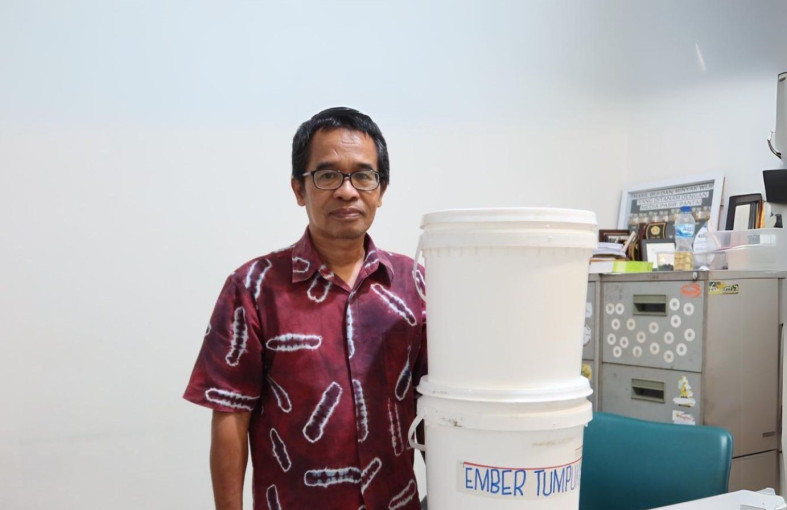
Food waste is a persistent problem that is not easily solved. As populations grow, the amount of food waste inevitably increases. For many, food waste is seen as something that cannot be processed and must be discarded quickly before it rots and emits unpleasant odors.
Nasih Widya Yuwono, a lecturer at the UGM Faculty of Agriculture (Agriculture UGM), has long been developing an innovative method for processing food or organic waste: the stacked bucket method.
This method uses a stack of two buckets. The top bucket holds the organic waste and features a filter that allows the liquid produced from decomposition (leachate) to drain into the bottom bucket with the help of gravity.
“The stacked bucket is designed to combine two buckets, one on top of the other. The upper bucket collects organic waste with a filter that allows the decomposition liquid (leachate) to drain into the lower bucket,” Yuwono explained to reporters on Thursday (Aug. 29).
Yuwono has been researching this stacked bucket method since 2000, and the innovation was first introduced on TVRI in 2018.
Despite the long history of research, Yuwono mentioned that the team encountered challenges during development, particularly the issue of foul odors from the leachate.
This issue arose in 2016 when his students were researching fish waste management. The leachate produced a strong fishy smell that led to complaints. Interestingly, when the leachate was about to be discarded, some samples did not emit a strong odor because they had been sun-dried.
“It was discovered that the leachate had been sun-dried,” he said.
Before adopting the stacked bucket method, Yuwono and his research team initially used large barrels, but due to their high cost and size, they abandoned the technique in favor of using more affordable and portable buckets.
“We eventually switched to using buckets because they are cheaper, easier to find, and more practical to transport,” he explained.
Yuwono further elaborated on how the stacked bucket method works by utilizing gravity. The liquid from food waste or fruit decomposition in the upper bucket drains into the lower bucket.
In addition to managing waste to prevent odors and produce leachate fertilizer, the remaining organic waste in the upper bucket can be further processed with the help of maggots from the Black Soldier Fly (BSF), which accelerates composting and can be used as animal feed.
“Maggots accelerate the process because their guts contain many microbes and enzymes, similar to worms, which aid in decomposition,” Yuwono explained.
He suggested that the stacked bucket method could be particularly beneficial in rural areas with ample farmland and a high demand for fertilizer. The waste could come from urban areas, creating a symbiotic relationship between urban and rural communities in waste management.
“Urban waste could be processed in rural areas, and the resulting fertilizer could enrich rural farmland, which in turn could be sold and used in urban areas, fostering a positive cycle in waste management,” he said.
Yuwono also proposed scaling up the stacked bucket idea to larger systems, such as reactors or large tanks. Agriculture UGM is open to collaborations with various parties.
He also expressed the possibility of UGM partnering with villages to provide training and resources for waste management, with the resulting agricultural products being returned to UGM.
Yuwono hopes that the stacked bucket method, which is easy to obtain and use, can become popular in the community, allowing more people to participate in waste management.
“The goal is for everyone to understand waste management and how to process it, as it’s affordable. The more people involved, the better,” he concluded.
Author: Leony
Editor: Gusti Grehenson

